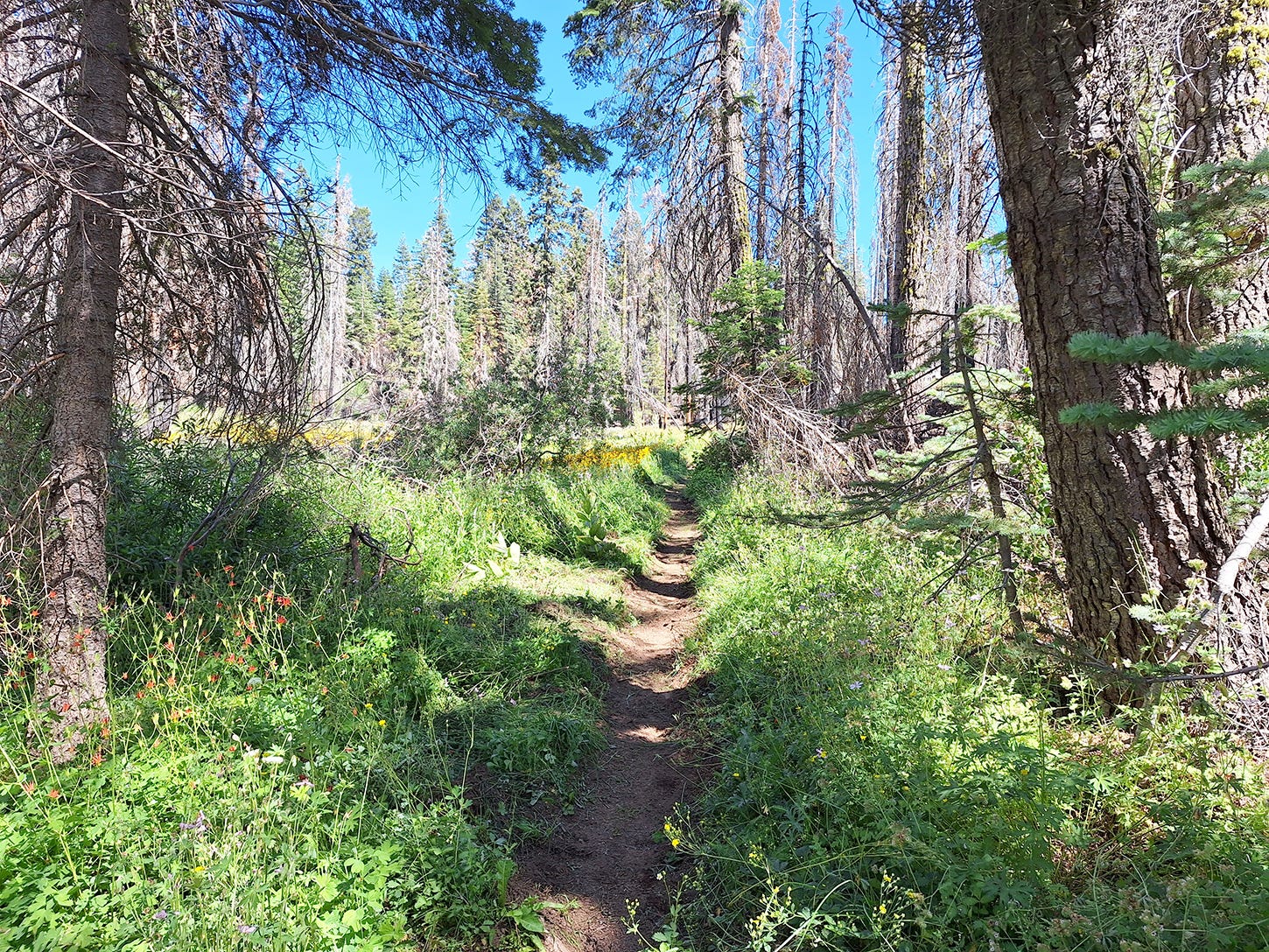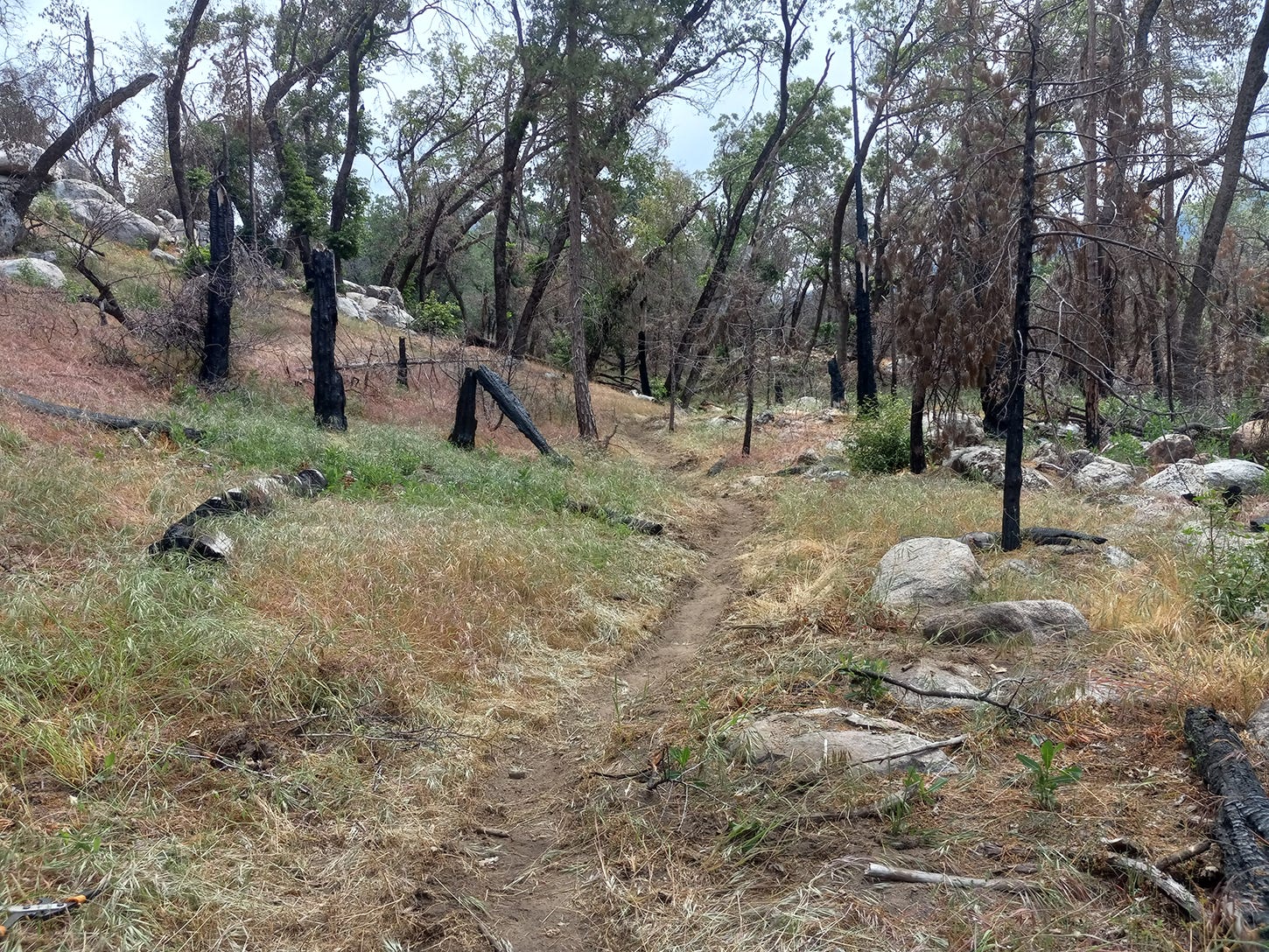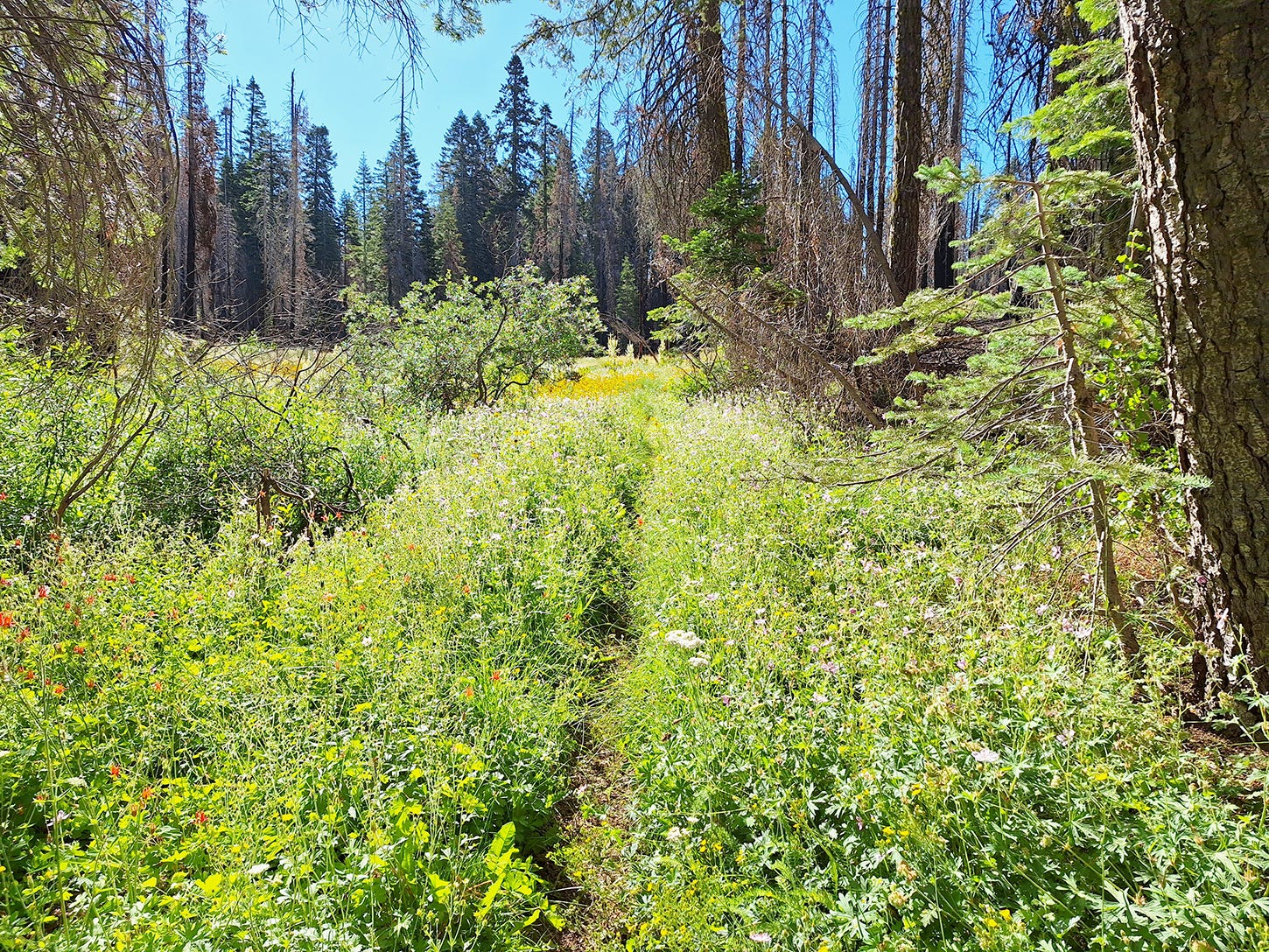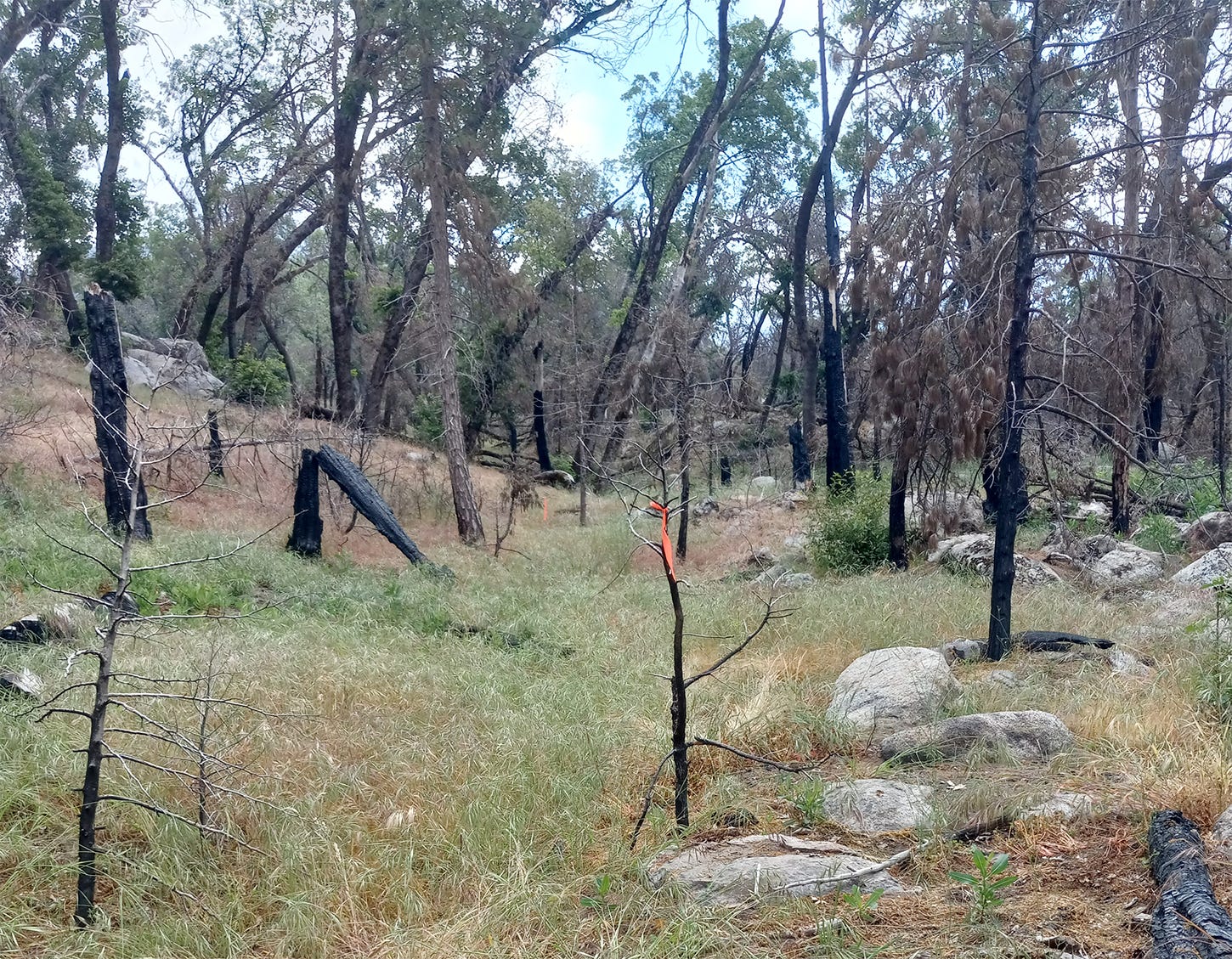Volume 2, Number 12 - Monday, Sept. 18, 2023
Published twice a week, on Monday and Thursday

Perspective
THE PHOTO ABOVE is a photo of the Freeman Creek Trail on Sequoia National Forest, where work to clear the trail was recently completed.
Denise Alonzo, public affairs officer for the Western Divide Ranger District, sent this photo and another (below) showing the trail before the recent work. She also sent a related news release describing work on other trails and before and after photos of the Lion Ridge Trail near California Hot Springs.
Clearing the trails will make access easier. Still, I find the dead trees in the background of the photo above heartbreaking because I remember the Freeman Creek Grove before the 2020 Castle Fire.
I love giant sequoias, but I have to admit I’m not a particularly outdoorsy person. Still, I managed a hike down the Freeman Creek Trail sometime between 2000 and 2009 (I can’t recall exactly when). I was with a group that included Art Cowley, known for his love of big trees. Art died in 2010, and you can read what I wrote about him then HERE. (I should note that I hiked down the trail to Lloyd Meadow Road, where my husband and son were waiting to drive me home to Porterville; most everyone else on the trip also hiked back up the trail to their vehicles).
I am pretty sure that Joan Stewart was on that hike, as well. I’ve just now learned that Joan died in February. You can read her obituary HERE, but it’s far too brief and doesn’t adequately address the many contributions she made to the California Native Plant Society. She also wrote a popular column about wildflowers for the weekly newspaper I published from 2000 to 2009.
From a newsletter for the Alta Peak Chapter of the CNPA from Fall 2001, I found an article about the Freeman Creek Grove that was likely written by Joan (who was the newsletter editor at the time). You can read the entire newsletter HERE, but I’m also sharing an excerpt about Freeman Creek Grove:
…the other reason this trip was planned was to introduce the Freeman Creek Sequoia Grove. This is the largest never-logged grove outside Sequoia National Park. According to one inventory there are 87 trees with diameters up to 15 feet, and 13 between 19-23 in diameter. These are spread out in two loose clusters, one centered in the Freeman Creek drainage, the other on the north-facing slopes toward Needles Lookout. Scattered in-between trees link these groups. One can look down over this area from Needles, to obtain a view of what a grove looks like from above.
Because of the 2020 wildfire, the grove looks nothing like this today, but I notice wildflowers blooming in the photo, and I’m sure Joan would have been able to identify all of them.
Here’s the news release about SQF trail work:
Over the past few months, miles of trail in the Western Divide Ranger District, Sequoia National Forest, received some needed attention. Work focused primarily on clearing fallen trees and other vegetation from the trail tread to re-open access.
A 5-person Student Conservation Association (SCA) crew joined Sequoia National Forest personnel to accomplish this work, funded by the Great American Outdoors Act and USDA Forest Service Pacific Southwest Region.
Additional work was accomplished on 7.5 miles of the Summit Trail (31E14), a mile of the Lewis Camp Trail(33E01), 4 miles along the Clicks Creek Trail (32E11), 3.5 miles on the Fish Creek/Jerkey Trail, a mile and a half on the Forks of the Kern Trail (33E20) and the President George Bush Tree Loop Trail.
Another 6-person SCA crew was hired to restore trails impacted by wildfires in 2020 and 2021. Forest officials anticipate an increase in trail maintenance activity over the next few years, supported by funds from the Great America Outdoors Act plus additional funding through Disaster Relief Supplemental Appropriations. In total, 11 SCA trail crew members were working across the district this summer. “There is a lot more to be done, and we hope to continue this work with our partners on an even larger scale in the future,” stated District Ranger Chris Sanders.
The Student Conservation Association helps to enhance, protect, and restore public lands, marine sanctuaries, cultural landmarks, and community green spaces in all 50 states. Its mission is to build the next generation of conservation leaders and inspire lifelong stewardship of the environment and communities by engaging young people in hands-on service to the land. More information about the Student Conservation Association can be found at www.thesca.org.

What Sequoia National Forest had to say about gray wolves last week
If you’re a paid subscriber to this newsletter, you received this news release in an Extra! Edition of the newsletter sent last Thursday. The news release was issued after the regular Thursday edition published.
From Sequoia National Forest — News Release, Sept. 14, 2023
California's gray wolf population vanished in the early 1900s during a nationwide eradication effort. In the 2000s, a handful made their way from Canada into Oregon, and in 2011, OR-7 (an adult male), who was part of the northeastern Oregon Imnaha pack, crossed the border into California.
Since then, the Golden State has become home to seven known established wolf packs: Whaleback Pack, Lassen Pack, Beckwourth Pack, and unnamed packs in Lassen, Plumas, Tehama, and Tulare counties. The California Department of Fish and Wildlife (CDFW) announced the sighting of the new Tulare County wolf pack in August.
According to a CDFW investigation, the southernmost wolf pack in Tulare County includes an adult female and four offspring (two males and two females). CDFW performed a DNA analysis indicating that the adult female is a direct descendant of OR-7. The four Tulare offspring also have a genetic link to the Lassen pack.
Wolves travel large distances, up to 12 miles in a single day. “The pack has been sited mostly in the Giant Sequoia National Monument,” stated Forest Supervisor Teresa Benson. “The Giant Sequoia National Monument covers over 300,000 acres within Tulare County, 2500 to 9700-foot elevations, and a diverse ecosystem offering the pack abundant room to roam.”
The Sequoia National Forest is actively engaged in fuels reduction projects and ecological restoration throughout the forest. These projects focus on reducing the probability of massive wildfires that could negatively impact sequoia groves, injuring or killing giant sequoias.
How the wolves affect ecosystems and predator/prey dynamics in the Giant Sequoia National Monument is unknown. Ultimately, if the wolves stay in the area and establish a population, they may affect prey behavior, which may impact plant growth. Federal and state agencies will monitor the wolves and work with wolf biologists to apply management protection and consideration for this endangered species.
Similar to bears and mountain lions, wolves pose a potential threat to livestock, such as cattle permitted to graze in the forest. Where the wolf pack roams consist of a mosaic of vegetation types with openings and areas of thick cover, in and around recent wildfire footprints. These areas are large and have roads, human settlements, and adequate water.
An abundance of prey, such as rabbits, squirrels, birds, mice, voles, and mule deer, are available. Livestock loss due to wolf attack is known to occur, though this is uncommon. In the event of depredation, State wolf recovery provisions pay full market value to every rancher verified to have lost livestock in wolf attacks. Visit CDFW Wolf Livestock Compensation Grants (ca.gov) for more information.
Wolves in California are protected under the California Endangered Species Act. It is prohibited to hunt, pursue, catch, capture, or kill wolves in the state. Learn more at Threatened and Endangered Species (ca.gov).
Some thoughts about those wolves
Reader Beth Lozano asked a question in the comments on last Thursday’s article about the Forest Service's response to René Voss, attorney for the Kern-Kaweah Chapter of the Sierra Club, the Sequoia Taskforce of the Sierra Club, the John Muir Project of Earth Island Institute and Sequoia ForestKeeper:
Is it just my imagination, or did the forest service’s response to the four conservation groups’ concern about the wolves sound like a form letter, merely acknowledging receipt of theirs, Lozano asked.
Yes, I would say that mostly the Forest Service did “merely” acknowledge receipt of the letter, although the agency also noted that it acknowledged obligations under the Endangered Species Act and National Environmental Policy Act to review new information.
If you read earlier reports about the gray wolves found on Sequoia National Forest earlier this summer, you will know that Voss suggested that SQF “pause” activities, including work in giant sequoia groves, until consultation with U.S. Fish and Wildlife Service and “determine whether any activities associated with those projects and others could adversely affect the wolves.”
It probably helps to have a little history here.
I think it’s a fair assessment that the groups Voss represents are always on the lookout for a reason to suggest that SQF “pause” activities. And I suspect that SQF officials didn’t need Voss to let them know their legal responsibilities. Although I imagine Voss can point to past legal action to suggest otherwise.
The war between environmental organizations and agencies that manage giant sequoias existed long before wolves decided to return to the Sierra Nevada.
So what comes next? Stay tuned.
Even more about wolves…
Also, regarding the wolves, I had a phone call from John Grant, another reader and former resident of Springville, California, who now lives in Montana.
Grant suggested that concerns about human activity in the Sierra Nevada disrupting the newly arrived gray wolves may be overblown. He lives near Yellowstone National Park and said he enjoys watching the wolves there.
“If they can flourish there, even with all those tourists, and in other places without the protection of national parks,” he said, there might not be a need to worry much about them in the Sierra.
“Wolves are pretty smart about not exceeding their habitat,” he said. “People have to expand the way they see this stuff.”
Wildfire, water & weather update
Cooler. That’s the weather word of the day, with little chance of precipitation, at least for the next few days. The best Sierra Nevada weather forecasts can be found at NWS Hanford, HERE, and NWS Sacramento, HERE. According to this ARTICLE (gift link) in the San Francisco Chronicle, the northern Sierra might get the first snow of the season sometime soon.
Wildfire update: Here’s the federal Situation Report for today. Across the country this morning, there are 43 uncontained large fires, in addition to 33 fires being managed under a strategy other than full suppression. That’s eight fewer uncontained large fires than last Thursday.
In California, not much has changed with WatchDuty HERE, and it shows most of the large fire activity in the state remains still in the far north. The Smith River Complex Fire has grown to more than 92,000 acres but is now at 65% containment.
The Redwood Fire in Sequoia National Park was at 1,158 acres Saturday, according to Inciweb. As reported previously, officials are managing the fire with a “confine and contain” strategy and expect it will grow to about 3,000 acres.
From the latest Inciweb report yesterday (HERE):
Yesterday, firefighters wrapped the Redwood Meadow Ranger Station with structure protection wrap to add another layer of defense from firing operations. Aerial and manual ignitions will pause for a few days and continue later this week. The fire is currently measured at 1,158 acres. Performing ignitions allows firefighters to regulate the intensity of the fire as fuels are consumed. Regulating the intensity of the fire will help to ensure that there are favorable fire effects within the burned area, especially as the fire moves through giant sequoia groves. When ignitions resume, smoke impacts are expected to be more pronounced overnight and in the morning in Grant Grove, Giant Forest, the foothills of Sequoia National Park, and the community of Three Rivers. However, ignitions will also serve to limit the overall duration of smoke impacts from the Redwood Fire.
Did you know you can comment here?
It’s easy to comment on items in this newsletter. Just scroll down, and you’ll find a comment box. You’re invited to join the conversation!
Giant sequoias in the news
• KBAK, the Fox station in Bakersfield, had this STORY a few days about the wolf pack on Sequoia National Forest.
• The California Council on Science and Technology has a report HERE that says a new study shows that improving the health of California’s forests cannot only reduce the risk of wildfire, it can also benefit people’s health.
The CCST, according to it’s LinkedIn page, is “a nonpartisan, nonprofit organization created via the California State Legislature in 1988 to provide objective advice from California's best scientists and research institutions on policy issues involving science. We are modeled after the National Academies — the official scholarly body serving the United States of America — to provide the State of California with a parallel network of institutional and individual advisors.”
• City Journal, which claims to be “nation’s premier urban-policy magazine,” has an article HERE by Edward Ring of the Manhattan Institute, a right-wing think tank, with the headline “Combustible California: Can the Golden State’s forests survive environmentalism?” Here’s an excerpt:
Earlier this summer, an environmentalist group that calls itself the John Muir Project, joined by a few other like-minded state and local organizations, sued the U.S. Forest Service. The transgression: a proposal to thin 13,000 acres of forest near Big Bear Lake, in the heart of California’s San Bernardino Mountains.
You would think they’d learn. One of the most devastating fires in California history raged through the San Bernardino Mountains nearly 20 years ago. The Old Fire, as it is now known, burned over 90,000 acres, destroyed nearly 1,000 homes and businesses, and forced the evacuation of more than 70,000 people.
Time passes. Forests regenerate. And if you choose to suppress natural fires, you either reduce forests through logging, grazing, controlled burns, and mechanical thinning, or you wait until they’re overgrown tinderboxes and then watch them burn to the ground in catastrophic “superfires.” And that is the apparent preference of California’s environmentalist lobby.
• The Associated Press published this article Sept. 13, not about giant sequoias, but forests in general. It’s a fact-check of sorts about a supposed claim that Microsoft founder Bill Gates is “backing efforts to but down 70 million acres of trees in order to fight global warming.” Read it HERE, and an excerpt:
There is no plan to cut down 70 million acres of trees. The U.S. Forest Service has a ten-year plan to reduce the risk of wildfires across millions of acres of forests in the American West through a combination of controlled burns, selective tree culls and other forest management strategies. Gates, separately, is among the investors in a company proposing to help thin out California’s densely packed forests and bury tree remains in Nevada.
Bury tree remains in Nevada? That’s a story for another day.
Historic photo of the week

Here’s what the Forest Service tells us about Converse Basin Grove: “Converse Basin Grove gives us a glimpse of a time when Manifest Destiny was the slogan of the day. The axe was king, and engineering feats in the mountains included lumber mills, water flumes, steam locomotives, and unrivaled willpower.”
Although the logging took place from about 1887 until 1908, this 1962 photo shows blackened stumps. You can read more about this grove and Stump Meadow HERE.
Thanks for reading!







I had a cabin in Alpine that burned. I used to visit the Freeman Creek Grove regularly and had several secret spots and clandestine routes to them. There used to be an illegal grow site somewhere nearby. I never found it, which is probably a good thing. Their refuse was all over, though. Haven't been back since the fire, but I'm glad to hear trail work is progressing.